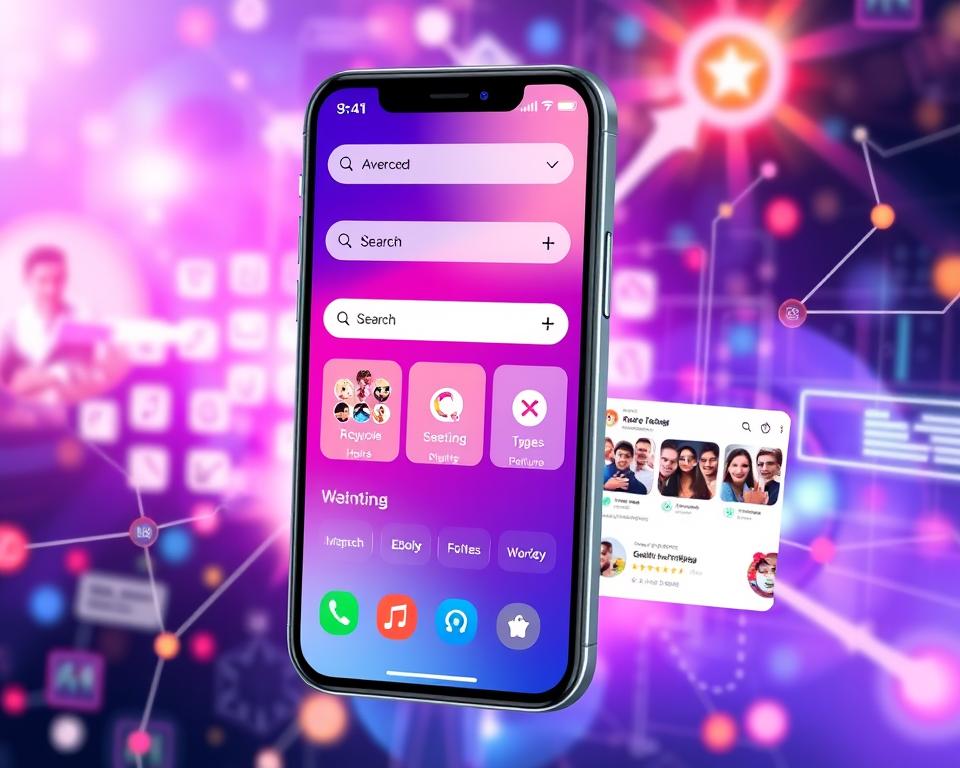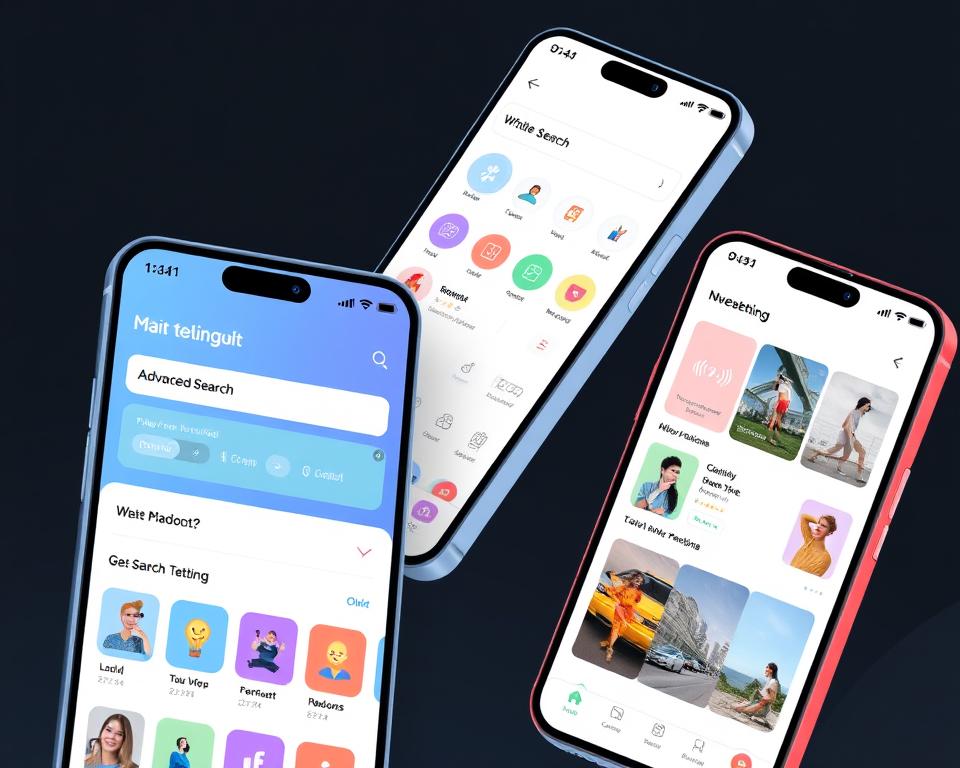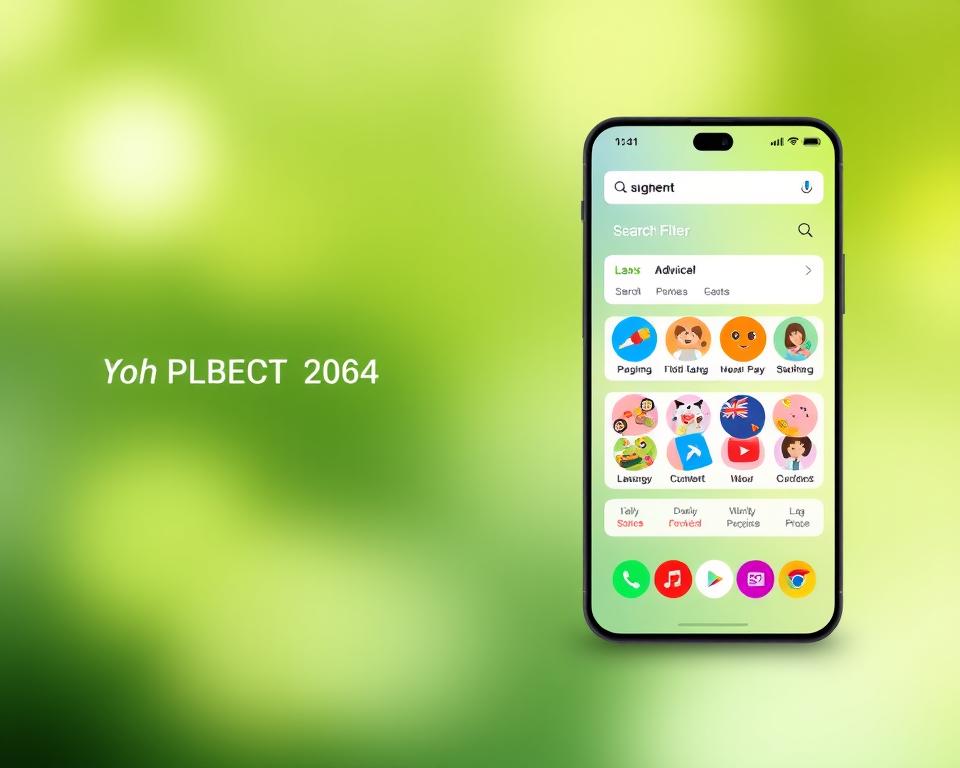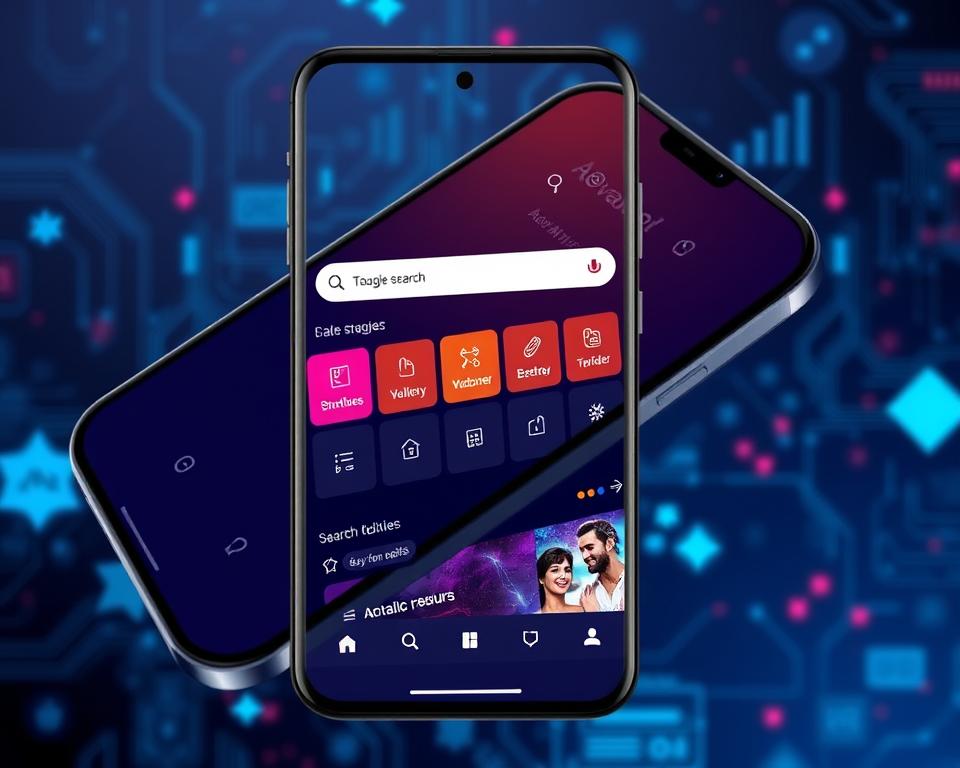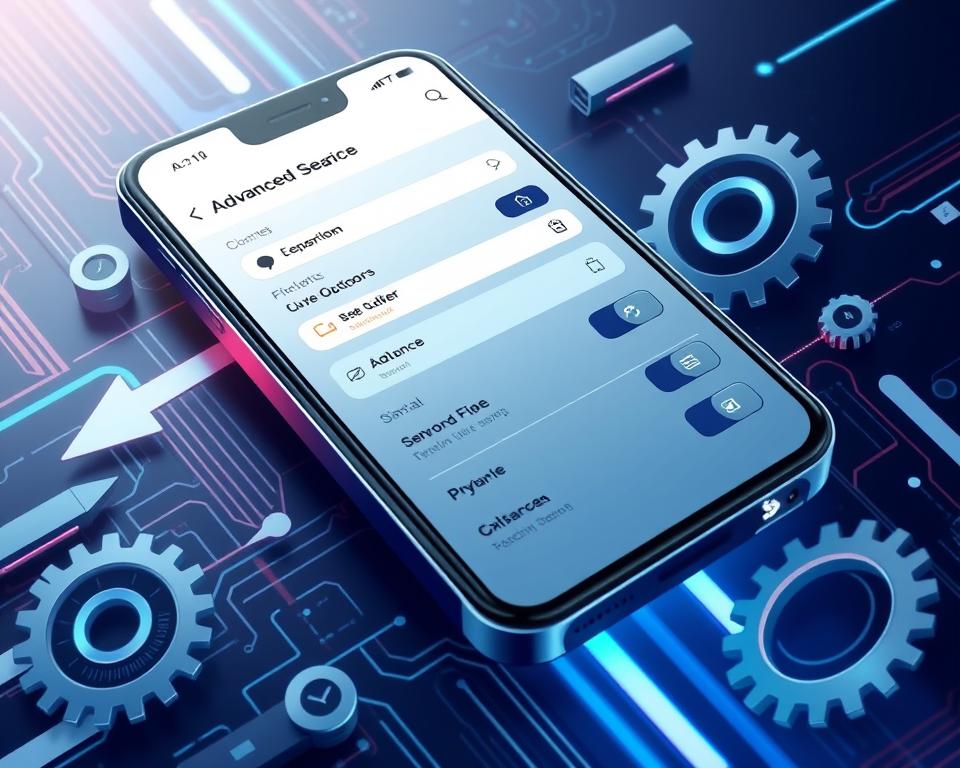In today’s fast world, mobile apps are a big part of our lives. Users want apps that are smarter and more personal. This guide will show you how to make a mobile app with top-notch search and filtering.
First, we’ll cover the basics of search apps. Then, we’ll talk about planning and designing your app. You’ll learn how to make your app stand out in a crowded market.
We’ll also dive into making your app’s search fast and filtering easy. You’ll see how to connect your app to databases for better search results. This guide is for anyone wanting to make a top-notch mobile app.
Table of Contents
Key Takeaways
- Understand the fundamental components of search-enabled mobile applications
- Learn about the essential development tools and technologies for mobile app development
- Discover best practices for planning your app’s search architecture and user interface
- Explore strategies for implementing real-time search functionality and dynamic filtering systems
- Gain insights into database integration and optimization for enhanced search performance
Understanding the Fundamentals of Mobile App Development with Search Features
Creating a mobile app with search and filtering needs a good grasp of key parts, important tools, and choosing the right framework. This part covers the basics of search-enabled mobile apps.
Key Components of Search-Enabled Mobile Applications
Good search in a mobile app has several key parts, including:
- Intuitive user interface for search input and display
- Efficient search algorithms and indexing mechanisms
- Intelligent filtering and sorting capabilities
- Real-time search responsiveness and performance
- Seamless integration with the app’s database and content
Essential Development Tools and Technologies
To build a search-enabled mobile app, you need various tools and technologies, such as:
- Mobile frameworks: React Native, Flutter, Android Studio, and Xcode
- Search components: Elasticsearch, Algolia, and Apache Solr
- Database solutions: MongoDB, PostgreSQL, and Firebase
- Testing tools: Appium, Espresso, and XCTest
Framework Selection Criteria
Picking the right mobile framework for your app is key. Consider these factors:
| Criteria | Importance |
|---|---|
| Performance and Scalability | High |
| Developer Productivity | Medium |
| Cross-Platform Compatibility | High |
| Community and Ecosystem | Medium |
Knowing these basics helps you start building a mobile app with advanced search and filtering. This app will meet your audience’s needs.
Planning Your App’s Search Architecture and User Interface
Creating a mobile app with great search and filtering needs careful planning. This stage is key to a smooth search experience in your app.
The search UX design starts with knowing how users behave and what they expect. By mapping out the search flow, you make an easy-to-use interface. This helps users navigate the search easily. It’s about understanding who your users are, how they search, and what they look for.
The app architecture is vital for search functionality. Good design choices in data, indexing, and queries improve the user interface planning and search performance.
- Define the search use cases and user scenarios
- Establish a clear information architecture for search
- Design intuitive search input and result presentation
- Incorporate advanced filtering and sorting capabilities
- Ensure seamless integration with the overall app navigation
- Test the search experience with representative user groups
“The success of a search-enabled mobile app hinges on the careful planning and design of its search architecture and user interface.”
By planning the search experience well, you make a mobile app that pleases users. It’s fast, relevant, and keeps users coming back.
| Key Considerations | Importance |
|---|---|
| User-centric search design | Ensures a seamless and intuitive search experience |
| Flexible search architecture | Enables scalability and adaptability for future growth |
| Optimized search performance | Provides fast and responsive search results |
| Comprehensive testing | Identifies and resolves issues before launch |
Setting Up the Development Environment for Search Implementation
Creating a mobile app with advanced search and filters needs a solid setup. This guide will help you with the key software, settings, and testing. This ensures your search features work smoothly.
Required Software and Dependencies
For a mobile app’s search to work well, you need certain software and tools. First, install these:
- Integrated Development Environment (IDE) like Android Studio or Xcode, based on your app’s platform
- Programming language SDK (e.g., Java, Swift, or Kotlin)
- Database management system (e.g., SQLite, Firebase, or MySQL)
- Search engine library or framework (e.g., Algolia, Elasticsearch, or Lucene)
- Any extra libraries or tools needed for your app’s setup
Configuration Best Practices
With the right software configuration in place, optimize your environment for search. Follow these best practices:
- Make sure your search engine library works well with your app’s data storage and management
- Set up your search engine’s settings, like indexing and relevancy ranking
- Use strong error handling and logging to find and fix problems during development
- Have clear coding rules for your search code
Testing Environment Setup
Testing is key to making sure your app’s search works well. Here’s how to set up a good testing environment:
- Make a testing database with data like your app’s content
- Write automated unit tests to check your search’s parts
- Do integration tests to see how your search works with other app parts
- Do end-to-end tests to mimic real user scenarios and check the search experience
- Use dependencies like performance tools to check your search’s speed and scalability
By following these steps, you’ll have a strong setup for your app’s search and filters. This will help your app work better for users.
Designing an Intuitive Search User Interface
Creating an intuitive UI design for mobile search is key. It makes the search process smooth and enjoyable. By following user-friendly interface rules, developers can make a mobile search design that helps users easily find what they need.
The layout of the search interface is very important. A clear search bar and easy-to-use filters and results make a big difference. Adding nice design elements also makes the interface look good and work well, as seen in this example.
Smart search suggestions and auto-complete features can make searching better. They guess what you might be looking for and make the search faster. Also, showing clear messages when there’s a problem keeps users feeling in control and trusting the app.
| Design Elements | Best Practices |
|---|---|
| Search Bar | Prominent placement, clear labeling, responsive design |
| Filters | Intuitive organization, easy access, dynamic filtering options |
| Search Results | Visually appealing layout, clear categorization, relevant information |
| Search Suggestions | Predictive auto-complete, smart recommendations, real-time feedback |
By focusing on UI design and search UX, developers can make a mobile search design that guides users well. This makes users happier with the app.
“The key to a great search experience is making it simple and intuitive for the user. Every design decision should focus on removing friction and empowering the user.” – UI/UX design expert
How to develop a mobile app with advanced search and filtering capabilities
Creating a mobile app with advanced search and filtering is key. This part covers the main steps, strategies, and tests needed. It’s all about making a search app that’s easy to use.
Core Development Steps
The process for making a search app includes several steps:
- First, define what the search needs to do and how users will use it.
- Then, design the search system and how it looks.
- Next, add the search feature using the right tech and frameworks.
- After that, link the search to the app’s backend and database.
- Make sure the search is fast and works well.
- Finally, test everything to make sure it’s solid and works right.
Implementation Strategies
There are ways to make the search better:
- Use AI for smarter search.
- Make search fast with real-time results.
- Let users filter their searches.
- Make sure the search fits with the app’s design.
Testing Methodologies
Testing is crucial for a good search app. Here are some important tests:
- Test each part of the search separately.
- Check how the search works with other parts of the app.
- Get feedback from users to find any problems.
- See how the search handles a lot of users at once.
By using these strategies, developers can make apps that search well. This makes users happy and keeps them coming back.
Implementing Real-Time Search Functionality
In the fast-paced world of mobile apps, real-time search is key. Users want instant results when they search. This is where search algorithms and query processing shine.
Real-time search starts with fast query processing. It’s about giving users quick, relevant answers. This means using smart search algorithms and techniques like indexing and auto-complete.
Developers need to design their app’s search carefully. They should focus on query processing and caching. They also need to make sure the app’s data sources work well together.
Streamlining Query Processing
Fast query processing is crucial for real-time search. Developers must use strong algorithms. These algorithms quickly match user inputs with the app’s data, giving the best results.
They might use fuzzy matching, stemming, and natural language processing. These methods help make search results more accurate.
| Feature | Description |
|---|---|
| Autocomplete | Anticipate user queries and provide instant suggestions, improving search efficiency and reducing typos. |
| Predictive Search | Analyze user behavior and preferences to offer personalized search results, enhancing the overall search experience. |
| Relevance Ranking | Implement advanced algorithms to prioritize the most relevant results based on various factors, such as content, user intent, and popularity. |
By using these search algorithms and query processing methods, developers can make search fast and fun. This makes their app stand out in a crowded market.
Creating Dynamic Filtering Systems
Building a mobile app with advanced search needs a strong filtering system. Dynamic filters help users find what they need quickly. Key parts include setting up filter categories, using multi-level filtering, and making sure it works well.
Filter Categories Implementation
Start by organizing your app’s content into clear filter categories. These should match what users need and your app’s purpose. For example, filters like price range, location, product type, brand, size, and color are common. It’s important to make these categories flexible and easy to change.
Multi-level Filtering Logic
For better filtering, use multi-level logic. This lets users apply many filters at once. For example, they might first filter by product category, then by price range and brand. Making this process easy and intuitive is key.
Performance Optimization
As you add more filters and complexity, you need to keep the system fast. Use caching, indexing, and efficient data retrieval to make filters work quickly. Always check and improve the system’s speed to keep users happy.
| Feature | Benefit |
|---|---|
| Dynamic Filters | Allows users to easily navigate and find relevant content or data |
| Multi-level Filtering | Enables users to refine search results with multiple criteria |
| Performance Optimization | Ensures a smooth and responsive filtering experience |
By focusing on these key areas, app developers can give users better search tools. This makes the app more enjoyable and useful for everyone.
Database Integration for Search Operations
Integrating your mobile app’s search with a strong database is key for a great user experience. This part talks about the important parts of database integration. It covers efficient search indexing, smooth data retrieval, and picking the best database for your app.
Optimizing Search Indexing
Good search indexing is the base for quick and accurate search results. Make sure your database indexes the right data fields for users to search. Use advanced indexing like full-text search to make searching better and help users find what they need.
Efficient Data Retrieval
Fast data retrieval is vital for a smooth search experience. Work on your database queries to cut down on wait times. Look into caching, database denormalization, and other ways to speed things up so users don’t get stuck waiting.
Selecting the Right Database Solution
The database choice is big in mobile app development. It affects search and user experience. Think about database integration, search indexing, data retrieval, and how it scales. NoSQL databases like MongoDB or Couchbase are good for handling unstructured data and fast search indexing and data retrieval.
Mastering database integration unlocks your app’s search power. It lets users easily find what they need.
“Integrating your mobile app’s search functionality with a robust database is a crucial step in delivering an exceptional user experience.”
Optimizing Search Performance and Speed
In mobile app development, fast and efficient search is key for a great user experience. Developers need to use caching mechanisms, query optimization techniques, and load testing strategies to achieve this.
Caching Mechanisms
A good caching system makes search faster. It stores data in a cache so it can be quickly shown. This cuts down on the need for slow database searches. Developers can use in-memory caching, client-side caching, or both to find the best balance.
Query Optimization Techniques
Improving search queries is vital for better search optimization and speed. Indexing, simplifying queries, and designing databases well can help. Using advanced features like full-text search can also make results faster and more accurate.
Load Testing Strategies
Load testing is key to making sure the search works well under heavy use. It simulates lots of users and checks how the app performs. This helps find and fix problems, making sure users have a smooth experience even when many are using the app.
By using these methods, developers can make apps that search fast and are easy to use. This leads to happier users and more engagement.
Implementing Advanced Search Features
In today’s mobile app world, users want more than basic search. Developers need to add cutting-edge search features to improve the user experience. Features like autocomplete, voice search, and image-based search can change how users use your app.
Autocomplete: Anticipating User Needs
Autocomplete is a big deal for advanced search in mobile apps. It predicts and shows possible search queries as users type. This makes searching easier and more fun. It also helps you understand what your users are looking for.
Voice Search: Hands-Free Convenience
Voice search lets users search without their hands. It uses speech recognition technology. This makes your app more accessible and meets the growing demand for voice commands.
Image Search: Visual Discovery
Image search lets users find content by looking at pictures. It’s great for finding similar products, landmarks, or related information. This feature can make your app more engaging and useful.
| Feature | Benefits | Implementation Considerations |
|---|---|---|
| Autocomplete |
|
|
| Voice Search |
|
|
| Image Search |
|
|
Adding these advanced search features can make your app’s search better. It gives users a great experience. Stay ahead and open up new ways for users to engage and discover.
“The future of search is not just about typing keywords, but about seamlessly integrating voice, images, and contextual data to deliver truly personalized and intuitive search experiences.”
Error Handling and Edge Cases in Search Functionality
Creating a mobile app with advanced search needs careful error handling and edge case management. These steps are key to a good user experience. They affect how happy customers are and how much they use the app. We’ll look at common search problems, how to fix them, and how to give users helpful feedback.
Common Search Errors
Search errors can be simple, like typos, or complex, like queries that don’t find anything. Understanding these errors is crucial. Here are some common ones:
- Incorrect or unclear search queries
- Not enough data in the database
- Problems with network connections
- Issues with the search algorithm
Error Recovery Methods
Fixing these errors needs a few strategies. Here are some ways to do it:
- Use smart suggestions and autocomplete to help users
- Give clear error messages that tell users how to fix the problem
- Use fuzzy search to catch small spelling mistakes
- Make the search algorithm better to find the best results
User Feedback Implementation
Listening to user feedback is key to making the search better. A good feedback system helps:
- Find and fix common search problems
- Learn what users like and how they search
- Fix important issues quickly
- Keep making the search better based on user feedback
“Good error handling and feedback are essential for a smooth search experience. By tackling common issues, you can make customers happier and more engaged with your app.”
Security Considerations for Search Features
Mobile apps are getting more advanced, with better search features. It’s vital to protect user data and keep search queries safe. This is key for any app’s success.
Protecting User Data
Users share personal info when using a mobile app’s search. This can include personal details, location, or even money info. It’s crucial to have strong search security to protect this data. This means:
- Encrypting data sent during searches
- Following strict data privacy rules
- Keeping security updates current
Securing Search Queries
Keeping search queries safe is also very important. Hackers might try to sneak in bad code or get into the app without permission. To stop this, developers should:
- Check and clean user input
- Use safe ways to connect to search engines
- Make sure data is sent securely
By focusing on search security and mobile app security, developers can make apps that are safe and easy to use. This is especially true for search-enabled mobile apps.
“Security should be a top priority when developing any application, especially those with advanced search capabilities. Neglecting this crucial aspect can lead to devastating consequences for both the app and its users.”
Testing and Quality Assurance
Creating a mobile app with advanced search and filtering needs a solid testing plan. This ensures the app works well and meets quality standards. We’ll look at unit testing, integration testing, and user acceptance testing to make sure the search function is top-notch.
Unit Testing Approaches
Unit testing is the base of QA testing. It checks each part of the search feature. This includes how it handles search inputs, processes queries, shows results, and handles edge cases. A thorough unit testing helps find and fix bugs early.
Integration Testing Methods
After unit testing, we check how all parts work together. Integration testing looks at how the search feature interacts with other app parts. This makes sure the search works well with the app’s design and gives a smooth experience.
User Acceptance Testing
- User acceptance testing (UAT) is the last step. It checks if the app meets user needs and expectations.
- During UAT, users test the search feature. They give feedback on how easy it is to use, how fast it is, and if it’s accurate.
- Using this feedback, we can improve the search feature. This makes the app better for users.
By using a detailed testing plan, we can make sure the search feature in the mobile app is reliable and meets user needs. This plan includes unit testing, integration testing, and user acceptance testing. It’s key to creating a high-quality app with a great search function.
| Testing Approach | Objective | Key Focus Areas |
|---|---|---|
| Unit Testing | Validate individual components and modules | Search input handling, query processing, result rendering, edge cases |
| Integration Testing | Assess interactions between components | Integration with database, user interface, and backend services |
| User Acceptance Testing | Ensure the search feature meets user expectations | Usability, responsiveness, accuracy, and overall user experience |
“Comprehensive testing is the key to delivering a search-enabled mobile app that exceeds user expectations.”
Maintenance and Updates
Creating a mobile app with advanced search is just the start. To keep your app successful, focus on app maintenance and regular updates. This means adding search updates, new feature enhancements, and managing version control well.
Keeping your search feature up-to-date is key. As search trends change, update your search algorithms and indexes. This keeps your app’s search results accurate and useful for users.
Don’t forget to add new features and improve your app. You could add more filter options, better search suggestions, or use external data. These feature enhancements help you stay competitive and keep users interested.
Good version control is also important. It makes sure updates go smoothly and users have a consistent experience. This includes tracking bug fixes and code changes for a smooth transition.
Updating a mobile app with advanced search needs a complete strategy. By focusing on search updates, adding new features, and managing versions, your app stays relevant and loved by users.
Conclusion
Creating a mobile app with advanced search and filtering has been exciting. It shows how important it is to know the basics of app development. Planning the search architecture and using the right tools are key steps.
Success comes from making search fast and efficient. It also means having a good filtering system and connecting databases smoothly. Paying attention to errors, security, and testing makes the app reliable.
The future of mobile search is bright, with new tech like natural language processing and voice search. Developers can make apps that search better and more personally. By keeping up with these trends, apps can meet user needs better and stay competitive.







